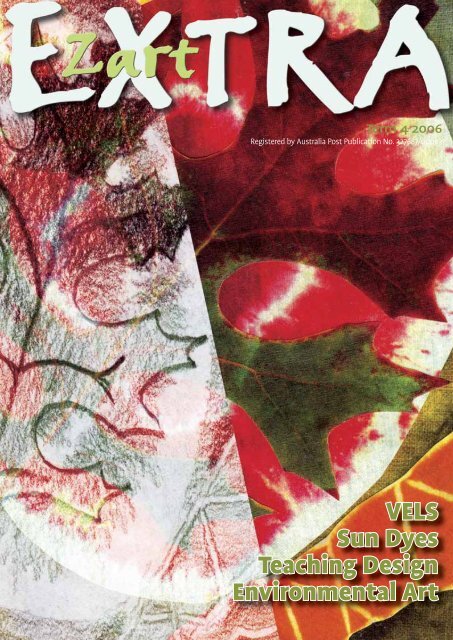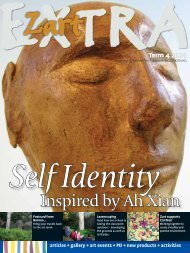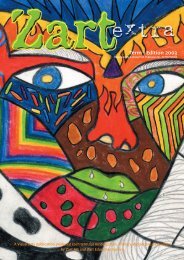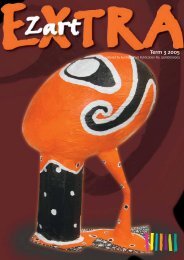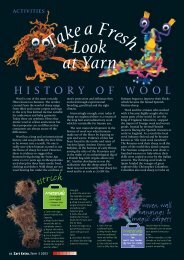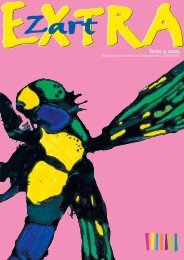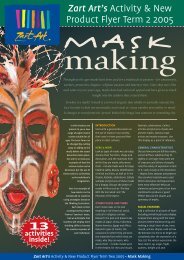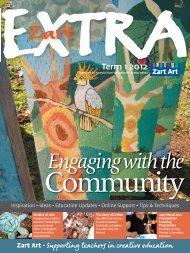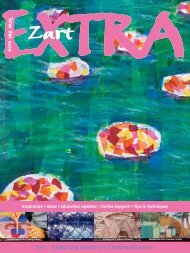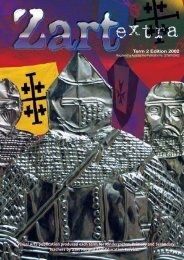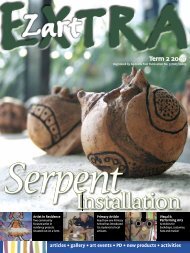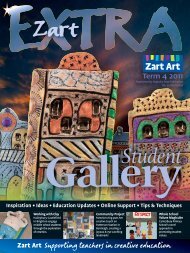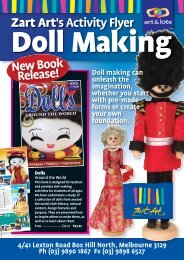Create successful ePaper yourself
Turn your PDF publications into a flip-book with our unique Google optimized e-Paper software.
<strong>Term</strong> 43 2006 2005<br />
Registered by Australia Post Publication No. 327687/00003<br />
VELS<br />
Sun Dyes<br />
Teaching Design<br />
Environmental <strong>Art</strong>
<strong>Art</strong> is a wonderful<br />
contents<br />
cover +<br />
page 3<br />
Secondary <strong>Art</strong>icle:<br />
Teaching design Yr 7-12<br />
Fairhills High School<br />
ENVIRONMENTAL<br />
page 5<br />
ART<br />
metal scraps and his works to reinforce their message.<br />
platform for students are displayed at the tip. The sculptures were<br />
to express their Students worked in displayed in the school foyer<br />
feelings and groups to discuss their for the community to view,<br />
views about approach and design for and the students were<br />
the world in a their piece. The sculptures required to present their<br />
meaningful way. needed to be solid and well work at assembly to their<br />
Primary <strong>Art</strong>icle<br />
Resources:<br />
INTERNET > search<br />
'Environmental artists'<br />
MATERIALS > Various junk from<br />
the recycle depot, tape, Viponds<br />
Paint, papier maché, various<br />
pens eg. Prockeys, feathers and<br />
decorating materials.<br />
Montrose Primary School<br />
Primary <strong>Art</strong>icle:<br />
Environmental art<br />
Montrose Primary<br />
School<br />
page 6<br />
VELS<br />
Implementing VELS in<br />
the classroom.<br />
page 7<br />
<strong>Zart</strong>'s Student Gallery<br />
What's on in term 4<br />
page 8<br />
Profile <strong>Art</strong>icle:<br />
Mosaically Motivated<br />
Auburn South Pre<br />
School<br />
page 9<br />
New Products<br />
Explore the wonderful<br />
possibilities of Wooden<br />
Doll starting points!<br />
ainting & Printing<br />
Dyes are a quick and easy way to hand paint si<br />
page 10<br />
Sun Dyes - are a quick and easy way<br />
hand paint silk, cotton, wool and<br />
fi ed by<br />
Silk Painting using Su<br />
Push Pins<br />
Stretch frame<br />
Gutta<br />
Manutex<br />
Silk<br />
Cold Batik Wax<br />
Activities:<br />
Painting & Printing<br />
with Sun Dyes<br />
wi l not act as a line, but<br />
page 12<br />
new resourc<br />
New Re<br />
New Resources<br />
New Catalogue Release - 2007<br />
The 2007 <strong>Zart</strong> <strong>Art</strong> Catalogue<br />
will be mailed out the week<br />
immediately after Melbourne Cup<br />
day, Monday 13th November.<br />
Budgets - 2007<br />
If your school requires your<br />
department to finish outstanding<br />
budget money by a certain time,<br />
and as yet you have not worked<br />
out your program requirements-<br />
<strong>Zart</strong> <strong>Art</strong> can help.<br />
If you would like to take<br />
advantage of the Back to<br />
School Prices, we are happy to<br />
supply your order at the end of<br />
term 4 2006 or January 2007,<br />
but not invoice your account<br />
until February 2007.<br />
We can invoice the remainder<br />
of your budget for general<br />
art materials now, and then<br />
provide a product credit, so<br />
that you may select your items<br />
as you need them without<br />
feeling pressured. Just speak<br />
to one of our Customer service<br />
people who can assist you with<br />
this procedure<br />
What’s Happening at <strong>Zart</strong> <strong>Art</strong> term Four<br />
Thanks for coming down to the zart<br />
art Annual expo. Once again huge<br />
bargains were on offer, free<br />
demonstrations and informative<br />
workshops! It was an enjoyable day and<br />
a great day for us to say hello to our<br />
customers.<br />
Christmas time is quickly approaching!<br />
this year zes is celebrating the Nutcracker<br />
christmas- with workshops throughout<br />
victoria and a full colour christmas<br />
publication (see page 12). We hope you<br />
enjoy our christmas program in 2006.<br />
you should now have your <strong>Zart</strong> <strong>Art</strong><br />
Christmas catalogue. We hope you<br />
enjoy our range of products from the<br />
new to the tried and true and easy<br />
festive activities! For up to date<br />
workshop details please refer to you<br />
insert or go to our website:<br />
www.zartart.com.au<br />
ZART EXTRA<br />
A Visual <strong>Art</strong>s<br />
publication<br />
produced each<br />
term for<br />
Pre-school,<br />
Primary &<br />
Secondary<br />
Teachers by<br />
<strong>Zart</strong> <strong>Art</strong> and<br />
<strong>Zart</strong> Education<br />
Service.<br />
ISSN 1448—8450<br />
There is no doubt that creativity is the<br />
most important human resource of<br />
all. Without creativity, there would be<br />
no progress, and we would be forever<br />
repeating the same patterns.<br />
Edward de Bono<br />
<strong>Zart</strong> Christmas Order Form<br />
Fax Number Error<br />
Dear Customers,<br />
We have discovered a printing error<br />
in our 2006 Christmas Catalogue<br />
order Form. Please note our correct<br />
fax number is<br />
03 9898 6527<br />
<strong>Zart</strong> Extra<br />
This publication is sent out to all<br />
schools in the first week of each<br />
term. This newsletter allows art<br />
teachers/co-ordinators to learn<br />
about what is happening in<br />
art education and what other<br />
art teachers are doing. You will<br />
find information on new art<br />
techniques and processes, the<br />
latest materials and resources<br />
on the market. Please note,<br />
all prices quoted are valid for<br />
the duration of the current term<br />
only and are subject to change<br />
without notice. The insert of the<br />
newsletter provides details of our<br />
2 www.zartart.com.au<br />
term's workshops, so teachers<br />
can then contact us and book<br />
into the workshop.<br />
<strong>Zart</strong> <strong>Art</strong> School &<br />
Wholesale Supplier<br />
<strong>Zart</strong> <strong>Art</strong> offers an extensive range<br />
of art materials, resources, craft<br />
and technology supplies. You<br />
will find competitive prices and<br />
efficient and quick service.<br />
5/41 Lexton Road, Box Hill North<br />
Melbourne Victoria 3129<br />
Ph: (03) 9890 1867<br />
Fax: (03) 9898 6527<br />
www.zartart.com.au<br />
zartart@zartart.com.au<br />
Hours:<br />
Mon - Fri: 8.30 am - 5.00 pm<br />
Sat: 8.30 am - 12.00 noon<br />
<strong>Zart</strong>’s Student Gallery<br />
The gallery features art works<br />
made by students of Prep to<br />
Year 12 from all around Victoria.<br />
Schools can arrange for students<br />
to visit the gallery, analyse the<br />
works of their contemporaries<br />
and then make a relevant piece<br />
of their own art work in our<br />
workshops with an art consultant.<br />
The gallery is also open to the<br />
public for viewing during opening<br />
hours (please see <strong>Zart</strong> hours) free<br />
of charge.<br />
For <strong>Term</strong> Gallery listings refer to<br />
our <strong>Zart</strong> Extra and our website.<br />
<strong>Zart</strong> Education Service<br />
<strong>Zart</strong> Education Service provides<br />
hands on professional development<br />
workshops for primary and<br />
secondary teachers, as well as<br />
LOTE teachers, Pre-schools, and<br />
librarians. Visual <strong>Art</strong>s workshops<br />
are regularly held at <strong>Zart</strong> and<br />
in metropolitan and country<br />
locations and upon request at your<br />
school, district or KLA’s group.<br />
Please refer to the ‘Workshop<br />
Insert’, a supplement to every<br />
<strong>Zart</strong> Extra or refer to our website<br />
for dates and times.<br />
<strong>Zart</strong>works (Retail Shop)<br />
<strong>Zart</strong>works have all your art and<br />
craft needs catering for both<br />
beginner and professional artists.<br />
You can select from a wide range<br />
of visual arts, craft and graphic<br />
supplies. Browse at your leisure<br />
or seek assistance from our<br />
experienced staff.<br />
3/41 Lexton Road, Box Hill North<br />
Melbourne, Victoria 3129<br />
Ph: (03) 9890 5110<br />
Fax: (03) 9898 6527<br />
<br />
E: zartworks@zartart.com.au<br />
Hours:<br />
Mon - Fri: 9.00 am - 5.00 pm<br />
Sat: 9.00 am - 12.00 noon
e<br />
urc<br />
Secondary <strong>Art</strong>icle<br />
es<br />
See our workshop<br />
insert for ZES's<br />
Nutcracker<br />
christmas PD<br />
Program<br />
It is never too early to teach design<br />
to students. Manipulating colours,<br />
shapes, tones, lines and textures are<br />
foundational to the creation of all art -<br />
both 2-dimensional and 3-dimensional.<br />
During the years of 7-12, students are<br />
taught the design elements and<br />
principles in both art and visual<br />
communication (referred to in senior<br />
years as the formal elements in an<br />
artwork)<br />
However, the purpose and outcome<br />
of both disciplines are quite different<br />
and need to be understood in order to<br />
assist students to be able to fully enter<br />
into the different modes of thinking<br />
used when creating either an artwork<br />
or a design for visual communication.<br />
When a student starts a painting or<br />
drawing, they tend to place their<br />
subject matter on the paper with little<br />
awareness of the frame in which they<br />
are working. They are then left with the<br />
problem of ‘filling in’ the background.<br />
When students are given a series of<br />
abstract design exercises, they can be<br />
helped to develop an appreciation of<br />
the abstract qualities of their artwork,<br />
and the sense of positive and negative<br />
spaces, and the overall composition<br />
that is being created by each and every<br />
placement of shape, line, texture, etc.<br />
This same awareness is needed in<br />
visual communication, so that the<br />
information being communicated is<br />
not only effective in reaching the<br />
target audience and answering the<br />
design brief, but has aesthetic appeal<br />
as well.<br />
Creating designs that ‘play’ with<br />
the elements and principles provide a<br />
non-threatening way of entering into<br />
the design process without having to<br />
face the ‘I can’t draw’ or ‘I haven’t got<br />
an idea’ issue.<br />
This process becomes really simple<br />
when the students are provided with<br />
a range of pre-coloured designs i.e.<br />
Pattern Paper, Glassine (sold by <strong>Zart</strong><br />
<strong>Art</strong>), newspapers, magazines, coloured<br />
paper and glue and scissors.<br />
By keeping the designs small<br />
- only 11x15 cm, several designs can<br />
be resolved in the space of a double<br />
lesson. An added bonus in this process<br />
is that students will inevitably<br />
‘express’ themselves in their designs.<br />
The ‘abstract’ nature of the first<br />
designs works almost like the famous<br />
‘ink blot’ tests - get your student<br />
talking about what the emerging<br />
images mean to them, and you will<br />
ASSESSMENT OF THE THINKING DOMAIN FOR THE V.E.L.S<br />
The thinking processes that are required in these tasks conform to:<br />
Bloom’s Taxonomy:<br />
Six Thinking Levels<br />
Knowing<br />
Understanding<br />
Applying<br />
Analysing<br />
Creating<br />
Evaluating<br />
Multiple intelligences can also be catered for.<br />
Verbal - discussing or explaining the designs<br />
Mathematical - students can consciously express<br />
mathematical pattern if they wish<br />
Visual - the whole process is visual<br />
Kinaesthetic - hands on<br />
Musical - students who love music can be directed to<br />
Kandinsky and can attempt to express music through<br />
shape and colour, etc.<br />
Intrapersonal - the process involves personal<br />
expression<br />
Interpersonal - students share their visual ‘solutions’<br />
and get feed-back from one another as well as from<br />
the teacher.<br />
<strong>Zart</strong> Extra_<strong>Term</strong> 4 2006 3
Secondary <strong>Art</strong>icle cont<br />
find all sorts of cues in<br />
which you can encourage<br />
further creative thought in<br />
that student.<br />
The initial exercises can<br />
be then photocopied and<br />
discussed in relation to the<br />
tonal balance. Students will<br />
now become aware of the<br />
‘weight’ that colours have.<br />
These designs can be<br />
interpreted into pencil<br />
rendering, pen and ink,<br />
watercolour pencils, or<br />
gouache, etc. Designs could<br />
also be interpreted into an<br />
all red or all blue version<br />
- an opportunity to teach<br />
colour mixing and paint<br />
application. Designs printed<br />
on to acetate (overhead<br />
film) and placed on a<br />
variety of backgrounds is<br />
another way to ‘see’ the<br />
design in a new way. In<br />
fact, the opportunities in<br />
which you can encourage<br />
the students to take their<br />
designs in many directions<br />
are endless - an approach<br />
that is essential in the VCE<br />
years. Images can be added<br />
eventually- either cut out or<br />
drawn by the student who<br />
is progressively becoming<br />
more confident that he<br />
can create an artwork that<br />
is “finished” - no empty<br />
spaces!!!<br />
Jennifer Cameron<br />
Visual <strong>Art</strong>s Teacher<br />
Fairhills High School<br />
DESIGN ELEMENTS<br />
Point<br />
Line<br />
Shape<br />
Form<br />
Tone<br />
Texture -2d<br />
Colour<br />
Letterform<br />
DESIGN PRINCIPLES<br />
Figure-ground<br />
Figure-ground<br />
Balance<br />
Contrast<br />
Cropping<br />
Hierarchy - Focal Point<br />
Scale<br />
Proportion<br />
Pattern<br />
Layout<br />
**the elements and principles used<br />
in visual communication can be<br />
found in the VCAA study guide.<br />
Purposes<br />
The design elements and principles<br />
are used for the “communication<br />
of a particular meaning to a target<br />
audience - usually with the objective<br />
of selling an idea, a service or a<br />
product.” Graphic designers aim to<br />
produce original designs in accordance<br />
with a design brief. Graphic art can<br />
also be used to reinforce or recreate a<br />
corporate image.<br />
FORMAL ELEMENTS<br />
Line<br />
Shape<br />
Form, Space, Mass, Volume<br />
Tone (Value)<br />
Texture-2d & 3d<br />
Colour<br />
Linguistic Philosophy<br />
FORMAL PRINCIPLES<br />
Subject Matter - Background/Foreground<br />
Subject Matter - Positive & Negative<br />
Balance<br />
Contrast<br />
Relationship of Compositional<br />
Elements to the Frame<br />
Emphasis – Focal Point<br />
Scale<br />
Proportion<br />
Rhythm And Repetition<br />
Composition<br />
Unity & Variety<br />
**the formal elements used in<br />
fine arts tend to be slightly more<br />
complex and vary according to<br />
different authors.<br />
Purposes<br />
The FORMAL ELEMENTS are used to<br />
Produce an artwork – 2D or 3D that<br />
is aesthetically pleasing or exciting.<br />
<strong>Art</strong>work usually has PHILISOPHICAL<br />
or EMOTIONAL significance to the<br />
artist. Some art is NARRATIVE – telling<br />
a story. “<strong>Art</strong> can also be POLITICAL<br />
or CONTROVERSIAL – challenging<br />
established conventions, culturally,<br />
socially or artistically.”<br />
4<br />
www.zartart.com.au
Primary <strong>Art</strong>icle<br />
Resources:<br />
INTERNET > search<br />
'Environmental artists'<br />
MATERIALS > Various junk<br />
from the recycle depot, tape,<br />
Viponds Paint, papier maché,<br />
various pens eg. Prockeys, feathers<br />
and decorating materials.<br />
ENVIRONMENTAL<br />
ART<br />
Montrose Primary School<br />
<strong>Art</strong> is a wonderful<br />
platform for<br />
students to<br />
express their<br />
feelings and<br />
views about<br />
the world in a<br />
meaningful way.<br />
Montrose Primary School<br />
is part of the Sustainable<br />
Schools Program and have<br />
been learning about ways to<br />
save our environment and<br />
our resources.<br />
The challenge for these<br />
artworks was to convey the<br />
message: “Don’t Rubbish<br />
our Environment.”<br />
Students looked at the<br />
work of environmental<br />
artists, such as that of John<br />
Dahlson, who makes<br />
sculptures from rubbish<br />
collected on the beach, and<br />
also William Wareham, the<br />
official artist-inresidence<br />
at San<br />
Francisco’s rubbish tip.<br />
Wareham creates<br />
sculptures from<br />
metal scraps and his works<br />
are displayed at the tip.<br />
Students worked in<br />
groups to discuss their<br />
approach and design for<br />
their piece. The sculptures<br />
needed to be solid and well<br />
designed so that they could<br />
be displayed.<br />
Over the next few weeks,<br />
students collected personal<br />
rubbish from home and<br />
school, eg. tickets, wrappers,<br />
batteries, tins, boxes. The<br />
art room also had a good<br />
array of junk from the<br />
recycle depot.<br />
During classes, the<br />
groups constructed their<br />
sculptures using tape and<br />
papier maché to cover and<br />
stabilize the structures. Over<br />
the following week they<br />
painted their work and<br />
decorated it using more of<br />
their personal rubbish and<br />
found objects.<br />
In conclusion, the<br />
students were also required<br />
to compose an original<br />
slogan for their sculptures<br />
to reinforce their message.<br />
The sculptures were<br />
displayed in the school foyer<br />
for the community to view,<br />
and the students were<br />
required to present their<br />
work at assembly to their<br />
peers.<br />
The results of this project<br />
have empowered the<br />
students involved to believe<br />
that through their art they<br />
can make a difference and<br />
communicate their opinions<br />
in a powerful and positive<br />
way.<br />
Mary Cooper<br />
Visual <strong>Art</strong>s Teacher<br />
Montrose Primary School<br />
<strong>Zart</strong> Extra_<strong>Term</strong> 4 2006 5
Education Update<br />
How is the implementation of VELS going in your art program'<br />
VELS PD Workshop with Di Olsson<br />
Most teachers<br />
in Victoria are<br />
currently devoting<br />
a great deal of time<br />
to the Victorian<br />
Essential Learning<br />
Standards – VELS –<br />
the new curriculum<br />
being progressively implemented in<br />
schools from 2006 to 2008. The proponents<br />
of VELS argue that the world is changing<br />
so fast students face an uncertain future<br />
simply because the future is an unknown<br />
- it will be so different from the past and<br />
the present. VELS is therefore an attempt<br />
to help students develop the ability to<br />
respond to change and adapt through new<br />
learning. The critics would argue that the<br />
implementation of VELS is resulting in over<br />
worked and highly stressed teachers. Those<br />
who teach The <strong>Art</strong>s have until 2008 to fully<br />
implement VELS.<br />
We thought you would be interested<br />
in the comments of other art teachers to<br />
our question: How is the implementation<br />
of VELS going in your art program<br />
VELS on the whole has not<br />
affected the course structure or<br />
the components of art in which<br />
I teach. However, I really like<br />
how art works or artists can<br />
be the impetus and starting<br />
point for classroom inquiry and<br />
integration. I also think that the<br />
interdisciplinary learning strands<br />
can really strengthen and deepen<br />
student learning.<br />
David Williamson<br />
Camberwell Grammar School<br />
VELS provides us with a sequential<br />
outline for the planning and<br />
implementing of an <strong>Art</strong>s program<br />
from levels 1-4 … It contains<br />
specific outcomes for each level.<br />
It provides suggested appropriate<br />
learning experiences across all<br />
facets of the <strong>Art</strong>s from which<br />
teachers can draw to develop<br />
relevant teaching and learning<br />
activities.<br />
Julie Lach<br />
Aspendale Gardens Primary<br />
School<br />
VELS has not impacted on my<br />
teaching program however in<br />
assessment tasks for student<br />
portfolios ‘outcome’ statements<br />
are now “standard “statements.<br />
The recognition VELS gives<br />
to interdisciplinary learning<br />
highlights what has been<br />
happening in art rooms for many<br />
years. Coming to understand VELS<br />
is an ongoing process that requires<br />
professional development eg. at<br />
network meetings and other PD<br />
sessions.<br />
One concern for many art<br />
teachers is the suggestion that<br />
the reporting of visual arts will be<br />
combined with performing arts<br />
(ie children get one mark for The<br />
<strong>Art</strong>s). The <strong>Art</strong>s covers visual arts,<br />
music, media, dance and drama in<br />
the primary school.<br />
Marion Hiland<br />
Surrey Hills Primary School<br />
Initially, the implementation of<br />
VELS into my program seemed like<br />
a daunting task. However, upon<br />
examination and reflection of my<br />
current arts program using the<br />
VELS framework, the connections<br />
between the two became clearer.<br />
Rethinking the explanation and<br />
presentation of my program have<br />
been the major shifts. Content and<br />
approach have remained much<br />
the same.<br />
Heather Lee<br />
Penleigh and Essendon<br />
Grammar<br />
Implementing VELS has been a<br />
journey that in the beginning I<br />
would have rather not taken but<br />
with a great deal of self-reflection<br />
and goal setting I’m feeling<br />
confident that I am developing<br />
a better understanding of my<br />
student’s learning enabling me to<br />
assist with their improvement in<br />
the Visual <strong>Art</strong>s.<br />
My first challenge was the task<br />
of understanding the VELS<br />
framework in particular the 3 core<br />
strands and how they interrelate<br />
with The <strong>Art</strong>s. I also needed to<br />
get a grasp of the language. e.g.<br />
domains and dimensions.<br />
With a growing understanding<br />
of VELS and a belief that its<br />
implementation would improve<br />
Dani Chak<br />
<strong>Zart</strong> Education Service<br />
my student’s learning I began<br />
planning the Visual <strong>Art</strong>s<br />
program under the headings<br />
of Interpersonal and Personal<br />
Learning. Visual <strong>Art</strong>s (Creating<br />
and Making, Exploring and<br />
Responding), Communication and<br />
Thinking. All of these domains<br />
are now an integral part of my<br />
program planning.<br />
Assessment and the<br />
documentation of student’s<br />
learning has become the focus<br />
of my professional learning.<br />
VELS has made me question<br />
the effectiveness of my<br />
assessment practices. I have been<br />
experimenting with a variety<br />
assessment tools that will best<br />
provide me with the data that will<br />
help me know my students so that<br />
I can better plan for their learning.<br />
I’m also concerned about the<br />
management of documentation.<br />
We are currently exploring the<br />
management of portfolios. We<br />
want them to be an effective<br />
documentation of ongoing<br />
assessment and a resource of<br />
learning for the student to reflect<br />
on and use to link future learning.<br />
The implementation of VELS in<br />
my art room has been a challenge<br />
and I know I’m on a never ending<br />
journey of learning. It seems<br />
that we had just mastered<br />
the implementation of one<br />
Department initiative when that<br />
one was replaced with the next.<br />
I guess that is indicative of our<br />
trade, teaching and learning, we<br />
can always improve.<br />
Di Olsson<br />
Trafalgar Primary School<br />
Attention Secondary Teachers<br />
<br />
<br />
<br />
<br />
<br />
<br />
<br />
<br />
<br />
<br />
<br />
<br />
<br />
<br />
<br />
<br />
<br />
<br />
<br />
<br />
<br />
<br />
<br />
<br />
<br />
<br />
<br />
<br />
<br />
<br />
<br />
<br />
<br />
<br />
<br />
<br />
6<br />
www.zartart.com.au
<strong>Zart</strong>’s Student Gallery<br />
situated at zart<br />
education service<br />
is <strong>Zart</strong>’s Student Gallery.<br />
In the Gallery you will find<br />
some outstanding visual<br />
art work created by<br />
students from Levels 1—7.<br />
Each term the exhibition<br />
is changed so a new<br />
display may be viewed over<br />
the holidays, supplying<br />
unlimited ideas for the<br />
following terms.<br />
Photos may be taken to<br />
build up your own folio<br />
of resources. The<br />
gallery also gives<br />
the students<br />
exhibiting work<br />
the opportunity<br />
to bring<br />
their families along to<br />
appreciate their visual art.<br />
We are always on the<br />
lookout for art work<br />
to be displayed in<br />
our gallery from both<br />
primary and secondary<br />
levels. If you have any<br />
pieces of art work that<br />
would be of some<br />
interest, please email<br />
photos of works to Jan,<br />
one term in advance.<br />
Please contact<br />
<strong>Zart</strong> Education Service<br />
for further information<br />
regarding the gallery<br />
on (03) 9890 1867 or<br />
by email on: jan@<br />
zartart.com.au<br />
term<br />
FOUR<br />
2006<br />
Oatlands Primary School<br />
Planning<br />
Discuss different shoe types and<br />
how they could construct them<br />
using cardboard and cylinders.<br />
Brainstorm ideas of what makes<br />
Melbourne unique; eg landmarks,<br />
famous people, activities. (I had<br />
photographic resources to inspire<br />
them)<br />
They then had to draw up their shoe<br />
and layout their chosen images (I<br />
suggested no more than 5 images)<br />
Construction<br />
Students traced around their own<br />
foot to get the basic shape, they then<br />
used cylinders and cardboard to<br />
build up the shoe shape.<br />
Students completed two layers<br />
of newspaper papier Mache over<br />
their shoe followed by one white<br />
layer of papier Mache. They were<br />
left to dry before painting.<br />
Decorating<br />
Students first transferred their<br />
images onto the shoes using pencil.<br />
They then painted each surface of<br />
their shoe.<br />
Di Cappadona<br />
Visual <strong>Art</strong>s Teacher<br />
Oatlands Primary School<br />
donvale christian College<br />
Coolaroo South Primary School<br />
Still Life<br />
Donvale Christian College<br />
Visual <strong>Art</strong> Work<br />
Rosanna Golf Links Primary School<br />
Tapestries<br />
Aitkin College<br />
Banners<br />
St Josephs Primary Hawthorn<br />
Luna Park<br />
Hawthorn West Primary School<br />
Yarra River Mural<br />
St Paul’s Primary School Monbulk<br />
Printing<br />
Strathcona Girls' Grammar<br />
Picasso ceramics<br />
Strathmore Primary School<br />
Wood works<br />
Koonung Secondary College<br />
<strong>Art</strong> Works<br />
View our gallery on the website!<br />
www.zartart.com.au<br />
St Leonards College Brighton<br />
Masks<br />
Oatlands Primary School<br />
Shoes<br />
Catholic Ladies College Eltham<br />
Dry Felting<br />
Chatham Primary School<br />
Still life<br />
Fairhills High School<br />
Design<br />
Montrose Primary School<br />
Environmental <strong>Art</strong><br />
Our Lady’s School Craigieburn<br />
Birds<br />
Beverley Hills Primary School<br />
Painted Jeans<br />
<strong>Zart</strong> Extra_<strong>Term</strong> 4 2006 7
profile article<br />
MOSAICALLY<br />
MOTIVATED<br />
For many years now, our pre-school<br />
emblem of a scarecrow has been etched<br />
into the memories of the many four-yearolds<br />
that have passed through our preschool<br />
doors.<br />
Up until one day in 2004, we had a<br />
very simple but characteristic scarecrow,<br />
which stood watch over the grounds. On<br />
arrival at kindergarten one morning, sadly<br />
I found that some vandals had taken our<br />
scarecrow apart. This along with the badly<br />
deteriorating building made for a very tired<br />
and sad looking playground.<br />
Of course, much discussion took place<br />
with the children about what had happened<br />
to our beloved scarecrow and how we<br />
could “solve” this problem. This inspired<br />
me to dream up ideas of how to re-create<br />
our scarecrow in a way that would see his<br />
lasting image for years to come.<br />
Having visited “The Mosaic Garden” in<br />
Hawthorn about that time, I was inspired<br />
to embark on the project of making a<br />
mosaic which would incorporate our<br />
scarecrow, along with other imagery to<br />
which the children could contribute.<br />
Second to this was my rationale of trying<br />
to improve the aesthetics of a pre-school<br />
that was seriously in need of some uplifting<br />
ambience to detract from the poor state of<br />
an aging façade.<br />
I began by visiting Camberwell Boys<br />
Grammar School, who very kindly allowed<br />
me to view Pamela Irving’s project entitled<br />
“Guardians of the Chess Set”, as well as<br />
Surrey Hills Primary School, who also have<br />
worked on mosaics in the past.<br />
From here I approached the children<br />
in my classroom, and we established<br />
many small project groups where we<br />
brainstormed ideas about what sorts of<br />
things we might like to put in our mosaic.<br />
At the time, we were breeding silkworms in<br />
our classroom, so this inspired ideas about<br />
“minibeasts” such as insects, spiders, and<br />
birds, etc.<br />
The plan was for a background<br />
consisting of nine hardboard panels, cojoined<br />
to create a 2.4 m x 1.8 m image of<br />
creatures in a garden. The children did the<br />
concept drawings for this, which included<br />
things like a butterfly, snail, spider’s web,<br />
lady beetle, bee, bird, worm, caterpillar,<br />
flowers, sun and rainbow. These types<br />
of symbolic representations of the world<br />
seemed to be familiar and often repeated in<br />
our children’s artwork.<br />
In front of the background was to be<br />
our scarecrow, which was to be a threedimensional<br />
construction made from all<br />
kinds of “junk” recyclables, that would be<br />
weather-resistant and firmly cemented<br />
into the ground. He was going to be on a<br />
stake in a garden bed, and we had planned<br />
to develop the surrounding garden area for<br />
planting with the children.<br />
With a tight budget to work within,<br />
the arduous task of sourcing as many<br />
tiles as I could began. This involved<br />
flyers to families, letters to tile shops for<br />
donations and physically sifting through a<br />
kaleidoscope of tiles to find the right colors<br />
and shades.<br />
Embarking on such a mammoth task<br />
was going to require the help of our local<br />
community, so the project opened up to<br />
parent helpers who were invited to come<br />
along both during the day and at night to<br />
work towards the outcome. I was staggered<br />
by the support that was offered by our<br />
parent helpers.<br />
Once the project was well off the<br />
ground, our local council announced<br />
that our pre-school would be demolished<br />
and re-located. The news of this muchneeded<br />
rescue from council was welcomed.<br />
However, the timing for our mosaic was<br />
not so good. It meant that logistically<br />
the original plan for our project would be<br />
difficult to carry out. Where was it going<br />
to go now And will there be sufficient wall<br />
space to mount it in our new playground<br />
We were so far into the project that we<br />
couldn’t just abandon it.<br />
The decision was made to continue with<br />
the plan in stages. Some two years later and<br />
we are happily settled into a beautiful new<br />
building, adorned by the fruits of our labor<br />
on the façade. Our 3D scarecrow figure,<br />
which I soon hope to take on with our new<br />
residents, has been put on hold until we<br />
reach stage 2 of our playground design.<br />
Juliane Rigoni<br />
Director<br />
Auburn South Pre-School<br />
8<br />
www.zartart.com.au
New Products<br />
italic prices do not include gst, Bold prices include GST • prices are valid until december 21st 2006<br />
Wooden<br />
Soldier<br />
This 15 cm tall<br />
wooden figure may be<br />
decorated as a soldier<br />
or simply the starting<br />
point for any human<br />
figure. Paint or dress<br />
with fabric.<br />
Each .......... $3.82 $4.20<br />
See page 12 for activities on<br />
The Nutcracker Christmas<br />
Wooden Male or<br />
Female—on Stand<br />
This 15 cm wooden figure with<br />
adjustable arms is ready to<br />
decorate in any costume. Paint,<br />
glue or stitch costumes on to the<br />
figure. From ballerinas to fairies,<br />
soldiers to football players,<br />
create a doll from this easy to<br />
decorate wooden figure<br />
Male<br />
Each .......................... $2.14 $2.35<br />
Female<br />
Each .......................... $2.14 $2.35<br />
WOODEN<br />
BEAD DOLLS<br />
These small wooden dolls are<br />
stand-alone figures that may<br />
be painted or dressed in fabric<br />
to create different characters.<br />
Available in three sizes.<br />
Small 7 cm<br />
Pkt of 10 ................... $6.42 $7.06<br />
Medium 7.5 cm<br />
Pkt of 10 ................... $7.43 $8.17<br />
Large 9.5 cm<br />
Pkt of 10 ................... $8.96 $9.86<br />
Push in then<br />
hang- so easy!<br />
Find this<br />
activity on<br />
our website!<br />
Wooden<br />
Pen Dolls<br />
This novelty wooden pen<br />
is a gift students may<br />
decorate in any style for<br />
Christmas or any other<br />
celebration. Use as the<br />
starting point for a doll. The<br />
pen is 14 cm from pen tip to<br />
top of the head.<br />
Pkt of 10 ........$17.12 $18.83<br />
Ornament Caps<br />
14 mm metal caps to push<br />
into a Poly Ball to create a<br />
hanging bauble. Will suit all<br />
size balls and creates a ready<br />
to hang bauble. Comes with<br />
cap and metal pin to push into<br />
the polystyrene.<br />
Pkt of 60 $8.37 $9.21<br />
Great<br />
starting<br />
point<br />
<strong>Zart</strong> Extra_<strong>Term</strong> 4 2006 9
Activity<br />
Painting & Printing<br />
Sun Dyes are a quick and easy way to hand paint silk, c<br />
Sun Dyes - are a quick and easy way<br />
to hand paint silk, cotton, wool and<br />
any natural fibres. They are fixed by<br />
heat setting - use a warm, dry iron.<br />
The Sun dyes can also be used for<br />
sun printing - this is a process in<br />
which the fabric can be painted<br />
and while it is still wet placed out<br />
in the sun with leaves, templates,<br />
feathers etc. anything which will<br />
leave an impression - the UV in the<br />
sun reacts with the pigment in the<br />
paints, creating a sun print.<br />
Silk Painting using Sun Dyes<br />
Materials<br />
Push Pins<br />
Stretch frame<br />
Gutta<br />
Manutex<br />
Silk<br />
Cold Batik Wax<br />
1. Stretch the silk on to<br />
a wooden frame, using 3<br />
point pins or push pins<br />
to attach the silk to the<br />
wooden frame.<br />
2. If using Gutta or Cold<br />
Batik Wax apply these<br />
to the stretched fabric<br />
first as they need to be<br />
totally dry prior to using<br />
the dyes.<br />
3. Start to apply the Sun<br />
Dyes using a soft brush.<br />
A soft brush is best as<br />
it will hold quite a lot of<br />
silk dye and will ensure<br />
an even finish.<br />
4. Note that the Cold<br />
Wax is not a resist, it<br />
will not act as a line, but<br />
simply create a texture.<br />
5. Note that Gutta will<br />
act as a resist and no<br />
dye will travel over or<br />
under the Gutta line.<br />
This is the best method<br />
for line or design work.<br />
6. Manutex, (dye<br />
thickener) can also be<br />
used with the dyes to<br />
create a design - with<br />
out the use of Gutta.<br />
This will provide a<br />
more painterly effect.<br />
Either thicken the dye<br />
with Manutex or paint<br />
Manutex over the<br />
stretched silk and allow<br />
to dry before painting<br />
with the dyes.<br />
7. Once you have<br />
finished your silk<br />
painting, leave the piece<br />
to air dry on the frame<br />
for at least 3-4 hrs<br />
(overnight is best)<br />
8. The piece, once<br />
dry, then needs to be<br />
ironed. Use a warm dry<br />
iron (place an old cloth<br />
/pressing fabric over the<br />
work). Iron for approx 6<br />
-10 minutes.<br />
9. Once the piece has<br />
been fixed (ironed) you<br />
may then proceed to<br />
remove Gutta, Cold<br />
Wax or Manutex build<br />
up with a warm soapy<br />
wash. This will remove<br />
any residue.<br />
10. Always iron silk<br />
whilst it is damp, as this<br />
will make it easier to<br />
remove any creases.<br />
You have now<br />
completed your silk<br />
or cotton painting.<br />
The pieces you<br />
produce can be<br />
wearable or artwork<br />
to hang on the walls.<br />
10<br />
www.zartart.com.au
Activity cont<br />
Fabric with Sun Dyes<br />
, cotton, wool and any natural fibres.<br />
Sun printing using Sun Dyes<br />
Materials<br />
Sun Dyes<br />
Silk or Cotton fabric<br />
Marbling Tray<br />
Foam Brush<br />
Templates/objects<br />
(leaves, feathers, wool,<br />
card stencils or Ezy Cut<br />
Stencil Paper etc) for<br />
leaving impressions<br />
1. Place the fabric into<br />
a Marbling Tray, or<br />
meat tray to keep the<br />
fabric in place.<br />
2. Shake the bottles<br />
of Sun Dye to mix<br />
prior to use. Pour a<br />
small amount out<br />
into a palette or paint<br />
container. Dye may be<br />
watered down by 50%<br />
or used full strength.<br />
3. Pre wet the fabric<br />
with a mist of water<br />
spray.<br />
4. Start to apply the<br />
dyes to your fabric with<br />
a foam or paintbrush.<br />
5. Paint in a quick<br />
manner - as the fabric<br />
needs to be wet or sun<br />
printing will not occur.<br />
6. While the fabric<br />
is still wet, move<br />
outdoors to a sunny<br />
but sheltered from the<br />
wind location.<br />
7. Start to arrange your<br />
objects on to the wet<br />
fabric. Ensure they are<br />
all weighed down in<br />
order to achieve sharp<br />
and clear images.<br />
Brush over paper or<br />
card stencils with water<br />
to help temporary<br />
adhesion to the fabric.<br />
8. Leave the fabric to<br />
dry in the direct sun.<br />
9. Once the fabric is<br />
completely dry the<br />
objects can be removed<br />
to reveal the sun print.<br />
10. To finish and fix the<br />
piece, the fabric will<br />
need to be ironed with<br />
a dry iron on a warm<br />
setting. Leave fabric<br />
for approximately two<br />
days prior to washing.<br />
Please note - for best<br />
results in sun printing<br />
Ensure you have<br />
shaken the contents of<br />
the bottle<br />
Make sure you<br />
are using a natural<br />
fibre (no polyester or<br />
polycotton)<br />
You will require a<br />
clear sunny day - as<br />
this process works on<br />
the sun’s UV rays.<br />
<strong>Zart</strong> Extra_<strong>Term</strong> 4 2006 11
PVA<br />
Felt<br />
Bead<br />
Cover Paper 51 x 76 cm Black<br />
Cover Paper 38 x 51 cm<br />
Cartridge Paper 110 gsm A4<br />
Crepe Paper Me tex<br />
Wool Tops<br />
Oil Pastels<br />
Marker black<br />
PVA<br />
Liquid Gli ter Fairy Dust<br />
PVA<br />
The Creative Sch ol Su ply Company 2006<br />
New Resources<br />
new resources<br />
<strong>Art</strong> Detective Second Edition<br />
Michele Stockley<br />
This book has been substantially revised and<br />
updated and provides a carefully structured<br />
but flexible approach to introducing<br />
students to the world of art.<br />
The second edition was specifically<br />
written to cater to the Victorian Essential<br />
Learning Standards (VELS). There is a full<br />
and comprehensive coverage of the <strong>Art</strong>s<br />
domain with the two dimensions ‘Creating<br />
and making’ and ‘Exploring and responding’<br />
being addressed with practical, classroombased<br />
questions and activities. Due Late<br />
Sept to early Oct<br />
192pp . . . . . . .$39.50 $43.45<br />
See our workshop insert<br />
for ZES's Nutcracker<br />
christmas PD Program<br />
Drawing<br />
Keith Micklewright<br />
Drawing is a language. Like all languages,<br />
if used fluently, it will allow individuals<br />
to express their ideas clearly. Contrary to<br />
the assumption that this visual literacy<br />
is a gift that cannot be learned, this book<br />
demonstrates that it is a highly teachable<br />
skill. As well as instructing the student how<br />
to draw, the book also serves as a visual<br />
handbook for artists and designers who<br />
need to explore and express ideas through<br />
drawing.<br />
168pp . . . . . . . $45.41 $49.95<br />
12 <strong>Zart</strong> Extra_<strong>Term</strong> 4 2006<br />
<strong>Art</strong> Detective Teacher<br />
Resource & Assessment Kit<br />
Ross Waterman<br />
The wire-bound Teacher book supports the<br />
use of <strong>Art</strong> Detective Second Edition and is<br />
accompanied by a CD-ROM with editable<br />
versions of:<br />
-Extensive assessment advice and course<br />
overviews for Victoria, Years 7 & 8<br />
-A bank of worksheets<br />
-Units of work and sample assessment tasks<br />
-Student sample responses to activities<br />
Due Late Nov to Early Dec<br />
Book & cd . . .$136.00 $149.60<br />
The Nutcracker<br />
Christmas<br />
The wonderful children’s fairytale of The<br />
Nutcracker is the focus of our Christmas<br />
2006. This year our Christmas book is<br />
based on this tale as well as a number of<br />
traditional Christmas decorations. The<br />
activities are designed to give classroom<br />
and visual art teachers a starting point<br />
for students to explore new visual art<br />
media, techniques and skills. Full colour<br />
publication. Available 1st October 2006<br />
56pp . . . . . . . $27.50 $30.25<br />
Faces Places and Inner Spaces<br />
Jean Sousa<br />
How do artists use faces, places, and inner<br />
spaces to express themselves and their<br />
worlds Every object in this book falls into at<br />
least one of these categories: in fact, you are<br />
likely to find that some can be one, two, or<br />
even all three! After exploring each of these<br />
topics, be prepared to take a new look at art<br />
and to better understand how artists shape<br />
our views of the world.<br />
48pp . . . . . . .$27.23 $29.95<br />
<strong>Art</strong> Detective Second Edition<br />
Poster Pack<br />
This poster pack is designed to cater for a<br />
whole course in junior <strong>Art</strong> and includes a<br />
wide selection of art works which feature in<br />
the book <strong>Art</strong> Detective.<br />
-30 posters (525 x 368 mm) printed on<br />
strong, gloss-laminated board<br />
-Durable flat-pack packaging to carry and<br />
store posters<br />
-Teacher notes on the reverse of each poster<br />
and a series of questions that will promote<br />
whole class discussion.<br />
Due Late Nov to Early Dec<br />
30 posters . .$180.00 $198.00<br />
introduction<br />
Cone<br />
Tree<br />
Christmas<br />
1. Poke a Satay Stick into<br />
the base and one into the top<br />
of a Poly Cone.<br />
2. Cover the top Satay Stick<br />
and the cone in PVA and<br />
wind a long length of<br />
Tinsel String around,<br />
starting at the Satay Stick<br />
and working around the<br />
cone until the cone is<br />
completely covered in<br />
colour.<br />
3. Wind another colour of<br />
Tinsel String over the first<br />
colour in a spiral pattern.<br />
4. Glue Sequin Stars around<br />
the tree to decorate.<br />
5. Make a base from a block<br />
of Plasticine. Cover the<br />
bottom Satay Stick and the<br />
Plasticine in PVA and<br />
sprinkle over Glitter until<br />
they are covered in Glitt e r.<br />
materials<br />
Poly Cone 10 cm<br />
Tinsel String<br />
Star Sequins<br />
Satay Stick<br />
Plasticine<br />
Glitter<br />
38 • the nutcracker christmas<br />
Elf Pen<br />
1. Paint a Wooden Pen Do l<br />
body with a chosen colour.<br />
Put aside to dry.<br />
2. Glue on eyes, nose, hair<br />
and beard to the head of<br />
the pen.<br />
3. Use Fel to create a hat<br />
and decorate with Metallic<br />
Braid and a Glitter Pom<br />
Pom.<br />
4. Glue the hat on to the<br />
head.<br />
5. Use Felt to create two<br />
arms and glue these on to<br />
the doll body.<br />
6. Tie Metallic Yarn<br />
around the mid point of<br />
the body for a belt. Decorate<br />
with a Sequin or metallic<br />
paper.<br />
7. Use a black marker to<br />
draw a line on the body to<br />
indicate trousers and boots.<br />
materials<br />
Wooden Pen Doll<br />
Shimmer Gla s Paint<br />
Metallic Braid<br />
Meta lic Yarn<br />
Curly Hair White<br />
Joggle Eyes 6 mm<br />
Arbee Craft Glue<br />
Gli ter Pom Pom 12 mm<br />
Marker black<br />
Handmade Prints<br />
Anne Desmet & Jim Anderson<br />
This book offers a user-friendly approach to<br />
printmaking without a press. All methods<br />
can be accomplished at many levels of<br />
expertise. The aim of this book is to provide<br />
a diverse range of ideas, where the most<br />
basic methods can be used to make highly<br />
ambitious work. With printmaking, it is<br />
possible to create images arguably more<br />
inventive and unusual than those produced<br />
by pencil or paintbrush.<br />
144pp . . . . . .$36.32 $39.95<br />
introduction<br />
20 • the nutcracker christmas<br />
The Encyclopedia of Mosaic<br />
Techniques<br />
Emma Biggs<br />
A complete guide to materials, tools and<br />
techniques used for creating fabulous<br />
mosaics. Discover new techniques and<br />
innovative styles for creating mosaics for<br />
a variety of purposes and learn foolproof<br />
methods for coordinating colour choices<br />
to produce dynamic designs of enduring<br />
appeal. This book also covers a wide range<br />
of tesserae, from traditional ceramic tiles to<br />
pebbles, broken pottery, found objects and<br />
other improvised materials.<br />
160pp . . . . . .$36.32 $39.95<br />
Mechanical Boy<br />
1. Use Crepe Paper Mettex to<br />
create a series of mechanical<br />
wheels and cogs by fold<br />
cutting and folding of the<br />
double-sided paper.<br />
2. Use different coloured Cover<br />
Paper to cut out a body shape,<br />
two thighs, two calves and two<br />
feet, two upper arms, two<br />
forearms, and two hands.<br />
3. Cover a sheet of black Cover<br />
Paper with Liquid<br />
Glitter and set<br />
aside to dry.<br />
4. Cut a head shape<br />
The Creative Sch ol Su ply Company 2006<br />
out of Cartridge Paper and<br />
draw the facial features on<br />
with Oil Pastels.<br />
5. Glue the body, head and<br />
body parts on to the black<br />
background.<br />
6. Use a black marker to draw<br />
a large dot where the body<br />
parts join.<br />
7. Glue the Mettex shapes on<br />
to the body.<br />
8. Glue Wool Tops on to<br />
the head for hair.<br />
The Creative Sch ol Su ply Company 2006<br />
materials<br />
1. Weave a Rainbow Weaving<br />
Mat and glue the woven mat<br />
down on to a sheet of Cartridge<br />
materials<br />
Rainbow Weaving Mat<br />
Sequins<br />
Creative Meta lic Braid<br />
Foilboard A4<br />
Cartridge Paper A4<br />
Cover Paper 25 x 38 cm<br />
Woven Card<br />
Paper.<br />
2. Cut the shape of the card from<br />
the Weaving Mat and cu the<br />
same shape but slightly larger,<br />
from a sheet of Foilboard.<br />
3. Glue the woven mat on to the<br />
Foilboard shape leaving a sma l<br />
border of Foilboard showing.<br />
4. Fold a sheet of Cover Paper in<br />
half and trace the shape of the<br />
card on to the fold of the Cover<br />
introduction<br />
Paper. Cut ou the shape on the<br />
fold to create a card.<br />
5. Glue the woven shape on to the<br />
lid of the folded Cover Paper<br />
card.<br />
6. Punch two holes into the top to<br />
the card and thread a length of<br />
Metallic Braid through the holes<br />
and tie a bow a the front.<br />
7. Decorate the front of the card<br />
with Sequins.<br />
the nutcracker christmas • 37<br />
Merry<br />
Christmas!<br />
We would like to wish<br />
you all a wonderful &<br />
safe Christmas.<br />
Thank you for your<br />
support this year.<br />
Because of your<br />
support we are able<br />
to work together to<br />
promote quality art<br />
education.<br />
Rex & Staff<br />
at <strong>Zart</strong> <strong>Art</strong><br />
blue italic prices do not include gst, Bold black prices include GST • prices are valid until 21st december 2006


